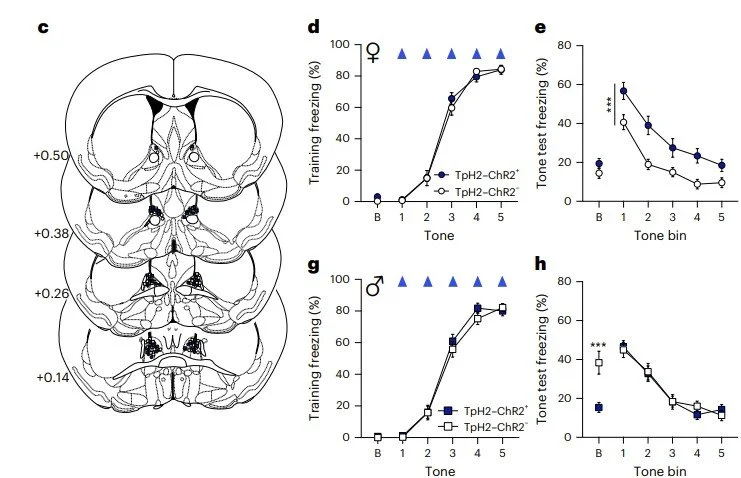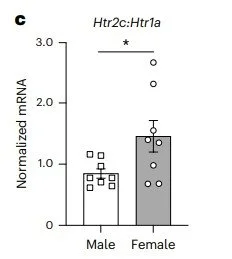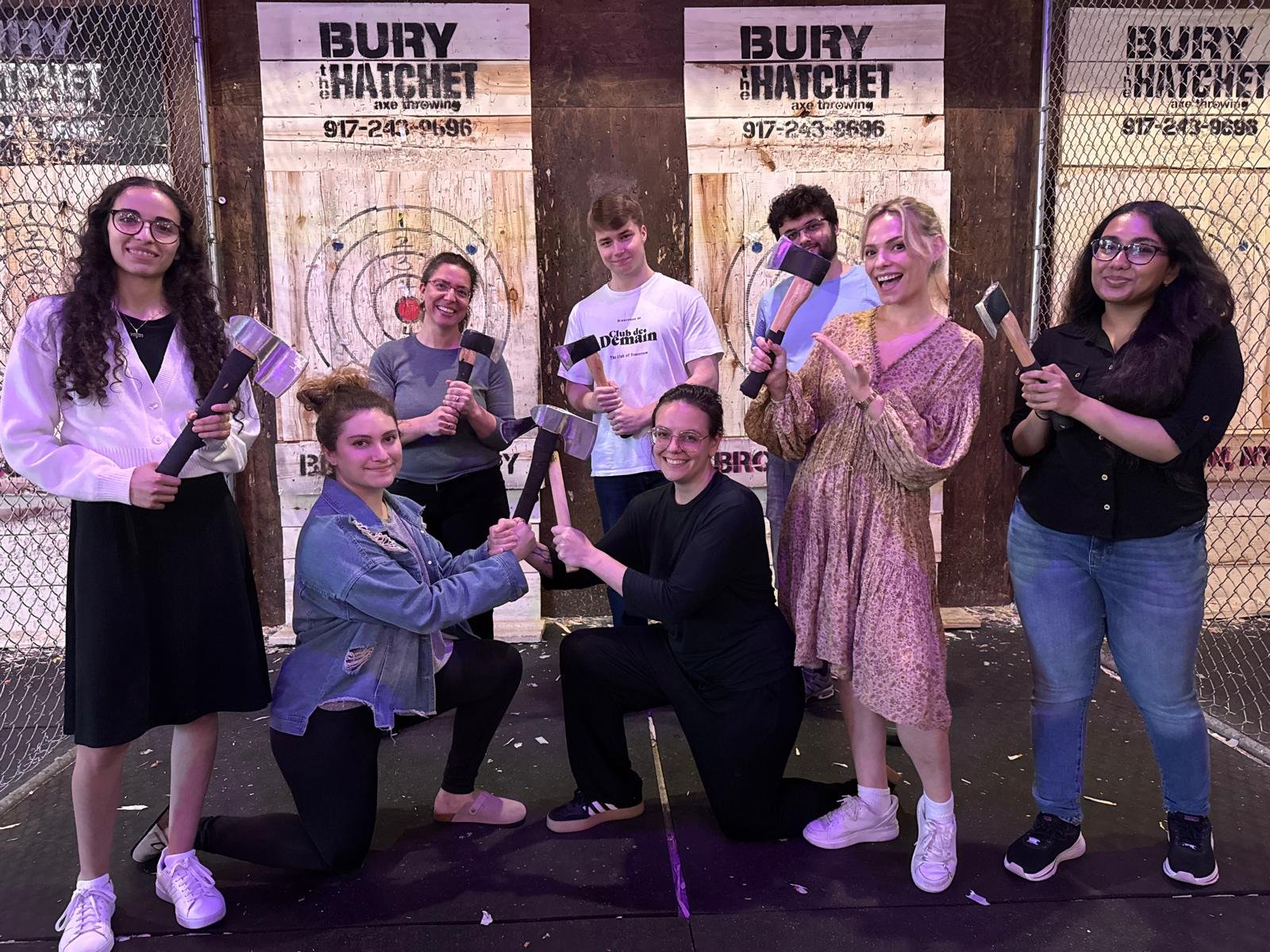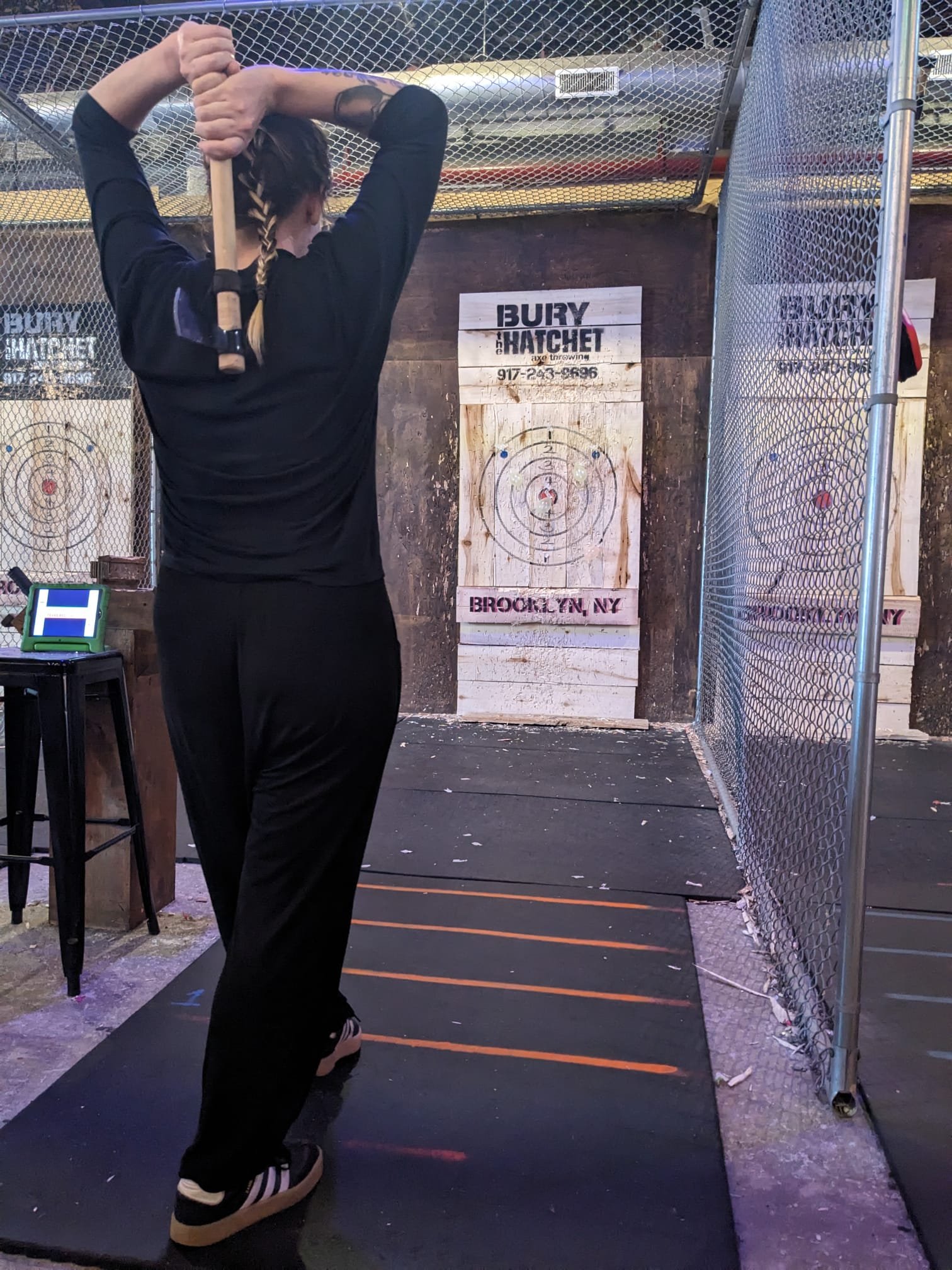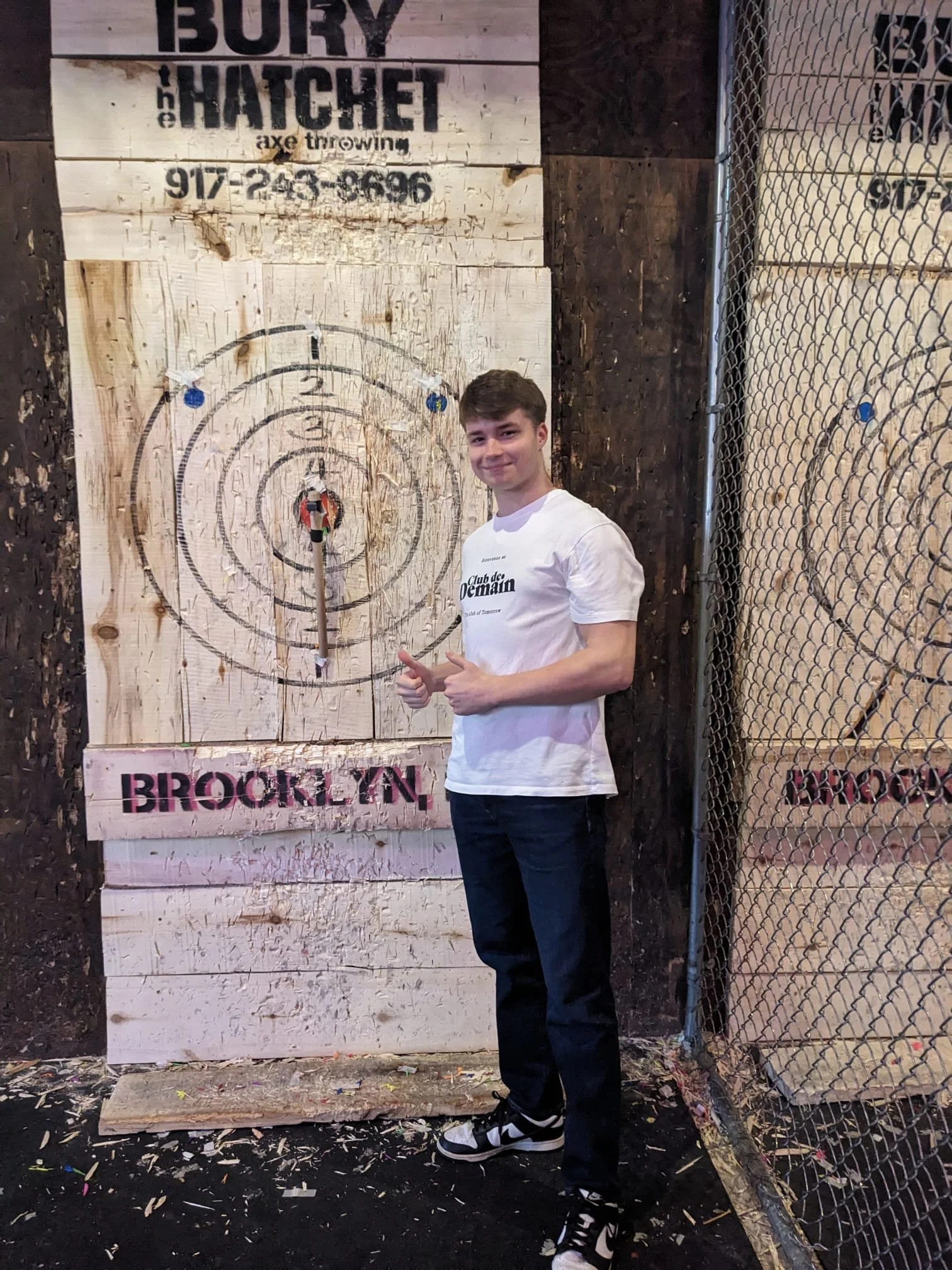Carolina was a graduate student in the lab who brought people together, and gave spark, insight and rigor to her science. She also cared deeply for the well-being of her fellow graduate students. After graduating, she tragically passed away from unexpected health complications in August of 2024. To honor her memory, a community of friends and colleagues have established The Carolina F. Henriques Travel Award for graduate students at the CUNY GC.
📢New Paper Alert📢📰
Serotonergic modulation of the BNST–CeA pathway reveals sex differences in fear learning.
Our collaboration with Nesha Burghardt’s lab is now out in Nature Neuroscience. This multifaceted work was valiantly led through all of its various stages of development by Becky Ravenelle with critical support from Jinah Lee and Carolina Fernandes-Henriques along the way. As always, a science projects travels down many paths, and our colleagues Jia Liu and Allyson Friedman were instrumental for making several important turns. An incredible team!
We dedicate the work to the memory of Carolina, who heartbreakingly left us before her time.
The Takeaway: Sex differences in the raphe–BNST–CeA pathway may contribute to the higher risk of PTSD in women.
What We Found: During fear learning, serotonin released in a region known as the bed nucleus of the stria terminalis (BNST) increases fear memory in females more than in males.
Serotonin stimulation in the BNST (c) during fear learning in females (d) and males (g), drives increased fear memory in females (e) but not in males (h) compared to controls.
We show that this is because the BNST is more easily activated by serotonin in females due to increased expression levels of the excitatory serotonin receptor 5HT2C in the BNST of females compared to males.
In females (c), cells in the the oval nucleus of the BNST are more active after serotonin stimulation during fear learning compared to controls, whereas in males (d), serotonin stimulation doesn’t change BNST activity after fear learning compared to controls that didn’t receive serotonin stimulation.
In the BNST of females, there is more transcription of the excitatory Htr2c than the inhibitory Htr1a receptor, whereas in males they transcription levels are more similar.
We demonstrate that serotonin release during fear learning leads to increased BNST communication with the central nucleus of the amygdala (CeA) during fear memory, which is carried out by oscillations in the high gamma range.
After serotonin stimulation, the fear cue evokes more oscillations in the high-gamma range in the BNST and CeA of females.
Females have more gamma synchrony in the BNST-CeA after serotonin stimulation (i) whereas males do not (j)
Mia is going to graduate school!
Mia, our fantabulous Lab Tech & Manager, wrangler of experiments, finances and various crises, is starting her doctoral degree. It’s been an great pleasure to have Mia in the lab and she will be missed, but luckily, she decided to join our CUNY Neuro program, so she won’t be far!
Looking forward to all the discoveries that Mia will make in grad school.
Emma's Last Day In Lab
We bade Emma a bittersweet farewell as she starts her postdoc at Regeneron. It’s been a true pleasure working with Emma and having her as a lab member. We are excited for this next phase of Emma’s career and are also glad that she will remain in the NYC area. Her awesome work will be coming out in a pre-print very soon!
June Happenings - Axe Throwing & Memory Hub
Axe throwing came back by popular demand! Team Metabond vs Team Texas Red competed with bullseyes and Polish pierogies to keep team mates strong.
The June Memory Hub meeting was hosted by Nesha Burghardt at Hunter. This is a monthly meeting where NYC neuroscientists who study learning and memory get together at different institutions across the city to discuss topics in the field in a friendly atmosphere that is geared towards bouncing around new ideas and questions among faculty and trainees. If you are interested in joining, please use the QR code. The next meeting will be a two-day conference in September.
Congratulations to Josh on his UGRC poster
Josh did a great job showing his work on how neural activity in the basal forebrain changes between early and late fear extinction at the Hunter UGRC.
This is the first work following up on our recent publication demonstrating that infralimbic inputs to the basal forebrain become more active during extinction learning and constrain defensive behavior. Big thanks to Mia for her work with Josh on this project and we have lots more to come!
Congratulations to Nawshin on receiving the CUNY Jonas E. Salk Award
Nawshin’s excellent work on the cognitive and cellular effects of acute vs chronic demyelination was recognized with the Jonas E. Salk Award! Thank you to Carmen Melendez-Vasquez, our partner in crime and resident myelin and multiple sclerosis expert, for her insight and co-mentorship. Nawshin’s work delves into how progressive demyelination affects anxiety, memory and neural activity in relevant brain regions.
New Paper Alert 📰📢
In our new paper we show the role of the infralimbic-to-ventral pallidum pathway in fear extinction learning and compare it to the more studied infralimbic-amygdala pathway.
We first show that IL projections to the ventral pallidum (VP) are denser than IL projections to the basolateral amygdala (BLA), especially from deeper layers.
We then show that neurons in the IL-ventral pallidum pathway become more active and excitable during extinction learning than retrieval.
We also show that inhibiting this pathway during extinction learning prevents the decrease in defensive freezing behavior (but inhibiting the PL-to-ventral pallidum pathway has no effect on extinction learning).
We propose a model of the IL acting as a switchboard operator when it communicates with downstream structures during fear extinction. During extinction learning, IL output to the ventral pallidum is more active, acting to constrain defensive freezing. Then, during extinction retrieval, IL output to the BLA is more active helping downregulate amygdala output (as shown in other work).
Congratulations to everyone whose work contributed to this finding. It is a bittersweet celebration, because we lost Carolina to health complications in August of 2024. We dedicate this work to her fiery spirit.
Thanks to members of the Friedman Lab for their help with the in-vitro recordings.
Neuroscientists Talk Shop
I recently had the pleasure of visiting several universities to talk about our work, and meet with lots of great neuroscientists working on the neuro-glial biology of learning and sensory processing. A big thank you to Anthony Burgos-Robles for hosting me at the University of Texas at San Antonio, Bénédicte Amilhon for hosting me at the Université de Montréal, and Susan Sangha for hosting me at the University of Indiana. Take a look at their work to learn more about learning!
At University of Texas San Antonio, I had the chance to speak with Charlie Wilson on his podcast Neuroscientists Talk Shop, where we discussed all things amygdala with Tony Burgos-Robles and Itamar Lerner
New paper celebration lunch
Our new paper in collaboration with the Burghardt Lab, “Social isolation during adolescence differentially affects spatial learning in adult male and female mice” is now out in Learning & Memory.
Champagne alley with Nesha Burghardt, Sadiyah Hanif, Jinah Lee and Mia Sclar
Hanif S, Sclar M, Lee J, Nichols C, Likhtik E, Burghardt NS. Social isolation during adolescence differentially affects spatial learning in adult male and female mice. Learn Mem. 2025 Jan 17;32(1):a054059.
Secret Holiday Lab Mate 2024 Game Night
the 2024 Secret Lab Mate board
We even beamed in Katie from Buenos Aires to play Codenames
One of Emma’s lucky code words is "satellite”
Congratulations to Dr. Emma Denholtz on a successful PhD defense!
On December 5, Emma defended her thesis, detailing a novel form of learning-dependent plasticity in the prefrontal cortex, which depends on neuro-glial interactions.
Celebrating Emma’s successful defense with a few members of her fantastic thesis committee, Patrizia Casaccia and Carmen Melendez. A heartfelt thanks also goes out to Susan Sangha and Nesha Burghardt for all of their guidance and advice on Emma’s work.
Emma giving a public seminar to a packed seminar room.
Emma’s Defense Avatar, She-RA, Princess of Power!
SFN 2024 in Chicago 10/5 - 10/9
Members of the lab are showing some fantastic work in Chicago this year
A season for congratulations and events!
Congratulations to Yuval who is leaving after more than 3 years in the lab to start an MD-PhD program at NYU!!
Congratulations to Nawshin who is graduating as a Valedictorian from Macaulay Honors!!
Congratulations to Mia who ran her first half-marathon, covering 13.1 miles of Brooklyn!!
Undergraduates Rock Spring Conferences - Congratulations Nawshin!
The undergrads have been doing a stellar job showcasing their work at spring conferences this year. Nawshin took home several awards for her work on the differential effects of acute vs chronic demyelination on behavior, myelin content and neural activity across the brain. Congratulations Nawshin!
Nawshin won a Best Poster award at Hunter’s UGRC.
Nawshin also won the Livingston Welch Award for Research from the Hunter Psychology Dept.
At the Hunter UGRC, George showed how chronic stress results in increased anxiety-like behavior even during a prolonged exposure to a non-stressful environment.
Congratulations to Dr. Carolina M. Fernandes-Henriques!!
On January 16th, Carolina beautifully defended her thesis, “The Role of the Infralimbic-Basal Forebrain Pathway in Fear Extinction”. It was a wonderful event and the first manuscript from her work is on its way out.
A heartfelt thank you to Carolina’s fantastic committee: Rob Froemke, Allyson Friedman, Andy Delamater, and Susana Mingote. Their contributions and discussions were most welcome and appreciated.
Carolina presenting her work
As Carolina is getting a PhD, she showed us her matrilineal lineage in Portugal. Each succeeding generation achieves a more advanced degree.
Lots of love came in from the room and via Zoom from Portugal.
Celebrations were in order!
Dr. Henriques’s celebratory cake and cheese bounty
Andy Delamater and Nesha Burghardt
Congratulations to Rhonda and Emma!
Congratulations to Rhonda (seen here as Green Fluorescent Protein) on passing her qualifying exam and moving on to candidacy!
Congratulations to Emma (seen here as Dylight 405) for getting accepted to the Advanced Neuroimaging Techniques course at Max Planck and for winning a Travel Award!
The Fluorescent Proteins at the Biology Halloween party
SFN 2023
We had a great time catching up with all the people, the science, and the tech at SfN in DC.
Breakfast Club style at SfN in DC (missing Nawshin, George, and Katie)
Carolina showing her thesis work on circuit communication during extinction learning
Emma showing her thesis work on oligodendrocyte - neuron interactions in learning
The mysteries of the Olive Garden were sampled en route back to NYC
Catch up with us at SFN
We will be at SFN, presenting our work and that of others.
Webinar on Making Posters for SFN
If you’re new to making posters, take a look at our SFN Webinar on “How To Make and Present a Poster”. In it, Marina Picciotto, Steve Maren, and I discuss various aspects of making a poster (from visuals to content), how to present to different audiences, and how to organize post-presentation networking.
https://neuronline.sfn.org/professional-development/how-to-make-and-present-a-poster-for-neuroscience-2023
Also, take a look at the webinar “Maximizing Your Time at SFN’s Annual Meeting” with Janice Naegele and Veronica Galvin, for strategies on how to prevent feeling overwhelmed.


